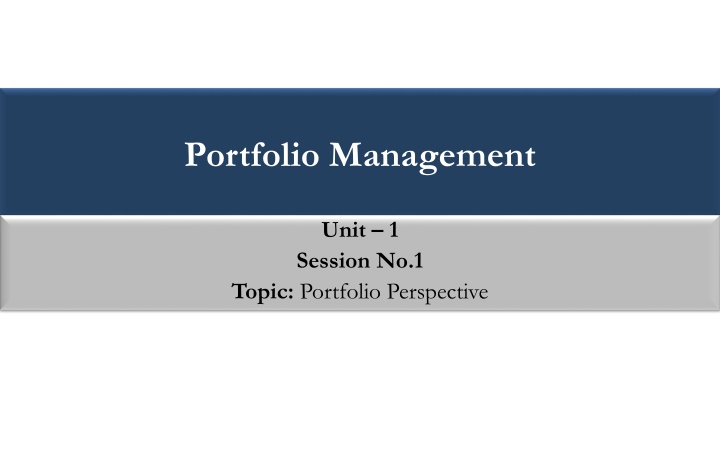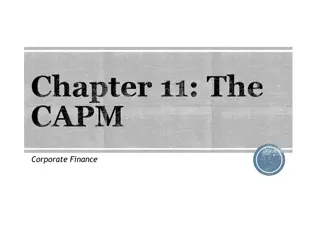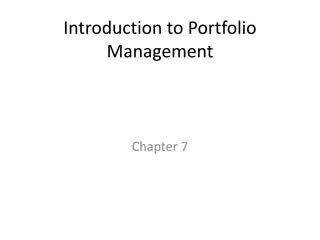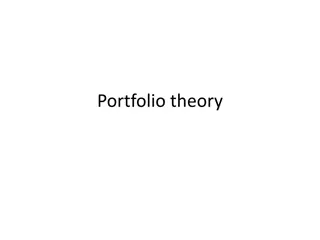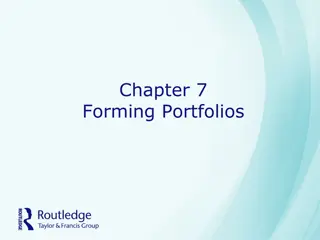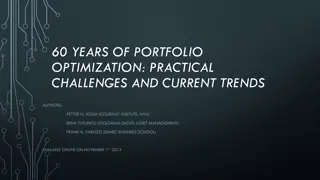Portfolio Management Fundamentals
This session delves into the essentials of portfolio management, covering topics such as defining a portfolio, understanding investments, investment management, types of investors, and portfolio securities. Gain insights into the modern portfolio theory and learn about different asset classes, including equities, bonds, and mutual funds.
Uploaded on Apr 04, 2025 | 0 Views
Download Presentation

Please find below an Image/Link to download the presentation.
The content on the website is provided AS IS for your information and personal use only. It may not be sold, licensed, or shared on other websites without obtaining consent from the author.If you encounter any issues during the download, it is possible that the publisher has removed the file from their server.
You are allowed to download the files provided on this website for personal or commercial use, subject to the condition that they are used lawfully. All files are the property of their respective owners.
The content on the website is provided AS IS for your information and personal use only. It may not be sold, licensed, or shared on other websites without obtaining consent from the author.
E N D
Presentation Transcript
Portfolio Management Unit 1 Session No.1 Topic: Portfolio Perspective
Session Plan Course Briefing What is a Portfolio? What is an Investment? What is Investment Management? & Need for Investment Management Discussion on different types of Investors. Summarizing and Q & A
Course Briefing Unit 1: Portfolio Management Process Unit 2: Managing Individual Investor Portfolios Managing Institutional Investor Portfolios Capital Market Expectations Asset Allocation Unit 3: Unit 4: Unit 5: Risk Management Monitoring and Rebalancing Evaluating Portfolio Performance Text Book: John L. Maginn et al. (2007), Managing Investment Portfolios: A Dynamic Process, John Wiley & Sons, Inc, 3rdEdition
What is a Portfolio? A Portfolio is a group of securities held together as investment. Investor invest their funds in a portfolio of securities rather than in a single security because they are risk averse. A grouping of financial assets such as stocks, bonds and cash equivalents, as well as their mutual, exchange-traded and closed- fund counterparts. Portfolios are held directly by investors and/or managed by financial professionals. Portfolio Securities: Stocks, Bonds, Mutual Funds, Derivatives, Real Estates, etc.,
What is a Portfolio? As per the modern portfolio theory, a diversified portfolio that includes different types or classes of securities; reduces the investment risk. It is because any one of the security may yield strong returns in any economic climate. What is a Portfolio? Ans: A group of securities Ans: Equities, Bonds, Mutual Funds etc., List the different securities in Portfolio. What is a equity? Ans: An equity is a title of ownership that represents a share in a company What is a Bond? Ans: Bonds are securities that represent a loan.
What is an Investment? Investment is an activity that is engaged in by people who have savings, i.e., investments are made from savings, or in other words, people invest their savings. Example: One person may purchase of Gold for the purpose of price appreciation A person may purchase an Insurance plan for the various benefits it promises in future What is the difference between savings and investment? Characteristics of Investment: Return Risk Safety Liquidity
What is Investment Management? Investment Management is the service of professionally investing money. As profession, Investment Management has its roots in the activities of Investment Bankers in managing the fortunes created by the industry. Investment Banker : An investment banker is a financial institution that assists individuals, corporations, and governments in raising financial capital by underwriting or acting as the client's agent in the issuance of securities (or both). Example: JP Morgan, HSBC, Citi Group, BNP Baribas, Barclays etc.,
Need for Investment Management Establishing Investment Policy Selecting a Portfolio Strategy: Active- applies information and forecasting techniques Passive- diversifies to match a market index Choosing a Strategy Selecting the Assets Measuring and Evaluating Performance Structure of the Money Management Process
Types of Investors Individual Investors Institutional Investors Banks Insurance Companies Mutual Funds Investment Companies Sovereign Wealth funds
Characteristics of Investors Investor Risk Tolerance Liquidity needs Income Needs Investment Horizon Individuals Depends on individual Low High Low Depends on Individual Short Long Depends on Individual High Low High Depends on Individual Pay interest Spending level Low Banks Endowments Insurance Long Life Short P & C Depends on fund Mutual Funds Depends on fund High Depends on fund
Q & A What is a Portfolio? List out the Securities. What is an Investment? List out the characteristics of Investment What is Investment Management? What are the different types of Investors? What are the distinguish characteristics of Investors?
